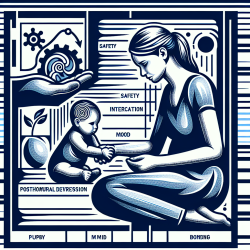Introduction
In the realm of speech-language pathology, understanding and interpreting patterns can significantly enhance the effectiveness of therapeutic interventions. The research article titled "Detecting Visual Texture Patterns in Binary Sequences through Pattern Features" by Dal Martello, Ota, Pietralla, and Maloney offers valuable insights into how human observers detect patterns amidst noise. This blog post will explore the key findings of this study and discuss how practitioners can leverage these insights to improve their skills and outcomes for children receiving therapy.
Understanding the Research
The study investigates human ability to detect texture patterns using a signal detection task. Observers were tasked with distinguishing between sequences generated by a random generator and those produced by a disrupted Markov sequence (DMS) generator. The sequences consisted of blue and yellow tokens, and the challenge was to identify patterns amidst varying levels of disruption.
Key findings revealed that human observers' sensitivity to texture patterns was significantly lower than that of an optimal Bayesian observer. The study explored whether observers relied on specific features of sequences, such as the length of the longest repeating subsequence, rather than the entire sequence. The researchers developed models to compare human performance with optimal Bayesian classifiers based on these features.
Implications for Practitioners
For practitioners in speech-language pathology, this research underscores the importance of understanding pattern recognition and decision-making processes. Here are some ways practitioners can apply these insights:
- Enhancing Pattern Recognition Skills: Practitioners can improve their ability to detect subtle patterns in children's speech and language behaviors by focusing on specific features, similar to the study's approach.
- Utilizing Data-Driven Models: Incorporating data-driven models, such as Bayesian decision theory, can help practitioners make more informed decisions when assessing and planning interventions.
- Training and Development: Practitioners can benefit from training programs that emphasize pattern recognition and decision-making skills, potentially leading to better therapeutic outcomes.
Encouraging Further Research
While this study provides valuable insights, it also opens avenues for further research. Practitioners are encouraged to explore additional features that may influence pattern recognition in therapeutic contexts. By collaborating with researchers, practitioners can contribute to the development of more effective models and interventions.
Conclusion
Understanding how humans perceive and interpret patterns can greatly enhance the practice of speech-language pathology. By applying the insights from this research, practitioners can improve their skills and ultimately achieve better outcomes for children in therapy. To read the original research paper, please follow this link: Detecting visual texture patterns in binary sequences through pattern features.










